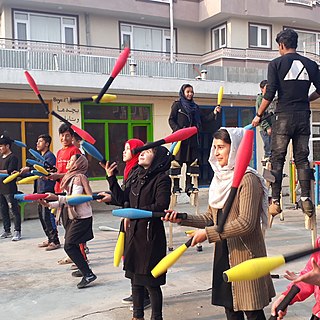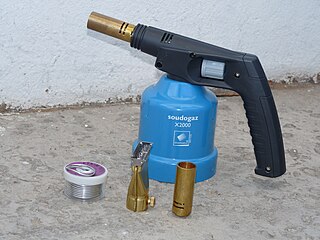Kerosene, paraffin, or lamp oil is a combustible hydrocarbon liquid which is derived from petroleum. It is widely used as a fuel in aviation as well as households. Its name derives from Greek: κηρός (keros) meaning "wax", and was registered as a trademark by Canadian geologist and inventor Abraham Gesner in 1854 before evolving into a generic trademark. It is sometimes spelled kerosine in scientific and industrial usage. The term kerosene is common in much of Argentina, Australia, Canada, India, New Zealand, Nigeria, and the United States, while the term paraffin is used in Chile, eastern Africa, South Africa, Norway, and in the United Kingdom. The term lamp oil, or the equivalent in the local languages, is common in the majority of Asia and the Southeastern United States. Liquid paraffin is a more viscous and highly refined product which is used as a laxative. Paraffin wax is a waxy solid extracted from petroleum.

A torch is a stick with combustible material at one end, which is ignited and used as a light source. Torches have been used throughout history, and are still used in processions, symbolic and religious events, and in juggling entertainment. In some countries "torch" in modern usage is the term for a battery-operated portable light.

Juggling is a physical skill, performed by a juggler, involving the manipulation of objects for recreation, entertainment, art or sport. The most recognizable form of juggling is toss juggling. Juggling can be the manipulation of one object or many objects at the same time, most often using one or two hands but also possible with feet. Jugglers often refer to the objects they juggle as props. The most common props are balls, clubs, or rings. Some jugglers use more dramatic objects such as knives, fire torches or chainsaws. The term juggling can also commonly refer to other prop-based manipulation skills, such as diabolo, plate spinning, devil sticks, poi, cigar boxes, contact juggling, hooping, yo-yo, and hat manipulation.

A candle is an ignitable wick embedded in wax, or another flammable solid substance such as tallow, that provides light, and in some cases, a fragrance. A candle can also provide heat or a method of keeping time.

A kerosene lamp is a type of lighting device that uses kerosene as a fuel. Kerosene lamps have a wick or mantle as light source, protected by a glass chimney or globe; lamps may be used on a table, or hand-held lanterns may be used for portable lighting. Like oil lamps, they are useful for lighting without electricity, such as in regions without rural electrification, in electrified areas during power outages, at campsites, and on boats. There are three types of kerosene lamp: flat-wick, central-draught, and mantle lamp. Kerosene lanterns meant for portable use have a flat wick and are made in dead-flame, hot-blast, and cold-blast variants.

A lantern is an often portable source of lighting, typically featuring a protective enclosure for the light source – historically usually a candle or a wick in oil, and often a battery-powered light in modern times – to make it easier to carry and hang up, and make it more reliable outdoors or in drafty interiors. Lanterns may also be used for signalling, as torches, or as general light-sources outdoors.

The manipulation of the devil stick is a form of gyroscopic juggling or equilibristics, consisting of manipulating one stick between one or two other sticks held one in each hand. The baton is lifted, struck, or stroked by the two control sticks, stabilizing the baton through gyroscopic motion.

Fire eating is the act of putting a flaming object into the mouth and extinguishing it. A fire eater can be an entertainer, a street performer, part of a sideshow or a circus act but has also been part of spiritual tradition in India.
Temperature play is a form of BDSM sensual play where objects and substances are used to stimulate the body's neuroreceptors for heat and cold for sensual effect.

Fire performance is a group of performance arts or skills that involve the manipulation of fire. Fire performance typically involves equipment or other objects made with one or more wicks which are designed to sustain a large enough flame to create a visual effect.

Juggling clubs are a prop used by jugglers. Juggling clubs are often simply called clubs by jugglers and sometimes are referred to as pins or batons by non-jugglers. Clubs are one of the three most popular props used by jugglers; the others being balls and rings.
Juggling practice has developed a wide range of patterns and forms which involve different types of manipulation, different props, numbers of props, and numbers of jugglers. The forms of juggling shown here are practiced by amateur, non-performing, hobby jugglers as well as by professional jugglers. The variations of juggling shown here are extensive but not exhaustive as juggling practice develops and creates new patterns on a regular basis. Jugglers do not consciously isolate their juggling into one of the categories shown; instead most jugglers will practice two or more forms, combining the varieties of juggling practice. Some forms are commonly mixed, for example: numbers and patterns with balls; while others are rarely mixed, for example: contact numbers passing. Many Western jugglers also practice other forms of object manipulation, such as diabolo, devil sticks, cigar box manipulation, fire-spinning, contact juggling, hat manipulation, poi, staff-spinning, balancing tricks, bar flair and general circus skills.

Poi is a performing art and also the name of the equipment used for its performance. As a skill toy, poi is an object or theatrical prop used for dexterity play or an object manipulation. As a performance art, poi involves swinging tethered weights through a variety of rhythmical and geometric patterns. Poi artists may also sing or dance while swinging their poi. Poi can be made from various materials with different handles, weights, and effects.

A fire fan is a fan shaped object usually constructed of non-combustible materials such as welded metal and Kevlar wick that is set alight. They are used for fire performance.

A kerosene heater, also known as a paraffin heater, is typically a portable, unvented, kerosene-fueled, space heating device. In Japan and other countries, they are a primary source of home heat. In the United States and Australia, they are a supplemental heat or a source of emergency heat during a power outage. Most kerosene heaters produce between 3.3 and 6.8 kilowatts.

Juggling rings, or simply "rings", are a popular prop used by jugglers, usually in sets of three or more, or in combination with other props such as balls or clubs. The rings used by jugglers are typically about 30 centimetres (12 in) in diameter and 3 millimetres (0.12 in) thick.
Object manipulation is a form of dexterity play or performance in which one or more people physically interact with one or more objects. Many object manipulation skills are recognised circus skills. Other object manipulation skills are linked to sport, magic, and everyday objects or practices. Many object manipulation skills use special props made for that purpose: examples include the varied circus props such as balls, clubs, hoops, rings, poi, staff, and devil sticks; magic props such as cards and coins; sports equipment such as nunchaku and footballs. Many other objects can also be used for manipulation skills. Object manipulation with ordinary items may be considered to be object manipulation when the object is used in an unusually stylised or skilful way or for a physical interaction outside of its socially acknowledged context or differently from its original purpose.

A blowtorch, also referred to as a blowlamp, is an ambient air fuel-burning gas lamp used for applying flame and heat to various applications, usually metalworking.
Juggling terminology, juggling terms:

A Swedish torch is a source of heat and light from a vertically set tree trunk, incised and burning in the middle. It became known in Europe during the 1600s and is now used by forest workers, and for leisure activities. Due to its flat surface and good embers, it can also be used for cooking. Compared to a campfire, it is more compact, and therefore several small heat sources can be distributed over an area.
















